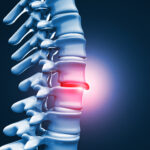
Innovative Cervical Disc Fusion Techniques
5 Reasons Why We Need Innovative Cervical Disc Fusion Techniques
Innovative cervical disc fusion techniques exist for a reason. They are paramount in addressing various challenges associated with traditional fusion methods and in improving patient outcomes. In comparison, non-innovative cervical disc fusions typically refer to all other traditional fusion techniques. These older techniques are ones that have been used for many years. They involve the removal of the diseased or damaged disc and the fusion of adjacent vertebrae. Fusion can be done using bone grafts and hardware such as plates, screws, or cages.
While these traditional fusion techniques do still work and have been effective in treating certain cervical spine conditions, they have limitations, like:
- Loss of Motion: Traditional fusion techniques typically result in the loss of motion at the fused segment, which can increase stress on adjacent spinal levels.
- Risk of Non-union: There is also a risk of non-union, which is where the bone graft fails to properly fuse with the adjacent vertebrae, leading to persistent symptoms.
- Adjacent Segment Degeneration: Older fusion procedures may accelerate the degeneration of adjacent spinal segments due to increased biomechanical stress.
And in most cases, all of these will necessitate future surgeries to correct. More surgeries mean more complications. More complications mean more surgeries. And so on. In contrast, newer, more innovative techniques aim to prevent this conundrum by focusing on these five principles:
- Preservations of Motion.
- Reduced Risk of Complications.
- Improved Patient Recovery.
- Tailored Treatment Options.
- And Addressing Degenerative Conditions.
Let’s look at these principles in a little more detail and then get into what some of these procedures and techniques look like.
Why Innovative Cervical Disc Fusion Procedures Are So Important
As we’re sure you can imagine, your cervical spine, or your neck, is a crucial component of your spine as a whole. Consisting of seven vertebrae labeled C1 through C7, it serves several vital functions. In fact, these functions are essential to your overall mobility, stability, and protection of your central nervous system. Here are some key aspects of the cervical spine that most people don’t know about:
- Structural Support: The cervical spine provides structural support for your head and facilitates various movements of your neck, like flexion, extension, lateral bending, and rotation.
- Protection of the Spinal Cord: Encased within the vertebral canal formed by the cervical vertebrae, your spinal cord extends from the base of your skull to the upper thoracic region.
- Facilitation of Sensory and Motor Function: Nerves branching off the spinal cord within your cervical spine innervate various structures in your head, neck, shoulders, arms, and hands.
- Support for Surrounding Structures: The cervical spine also provides attachment points for muscles, ligaments, and tendons that stabilize and move your neck.
- Integration with Adjacent Spinal Regions: The cervical spine interfaces with the cranial base above and the thoracic spine below, forming a continuum of the vertebral column.
Given its central role in supporting your head, the cervical spine is indispensable. It protects your spinal cord. Also, it helps facilitate movement. Not to mention, it integrates with adjacent spinal regions. As such, its continued healthy function is key to your mobility, sensory perception, and overall well-being. Consequently, preserving the health and function of the cervical spine is paramount in maintaining quality of life and mitigating the risk of neurological dysfunction or injury.
Understanding this, we can really get into and understand the guiding principles behind innovative cervical disc fusion procedures.
The 5 Principles of Innovation
As we mentioned earlier, traditional fusion techniques still work. However, here at Maxim Health, we don’t want to settle simply for “still working.” We want to go above and beyond for our patients. We want to give them:
- Preservation of Motion: Innovative cervical disc fusion methods aim to preserve motion in the affected segment of your spine. Maintaining motion helps to reduce stress on adjacent spinal segments, potentially mitigating the risk of adjacent segment degeneration.
- Reduced Risk of Complications: By adopting innovative techniques that preserve motion and anatomical alignment, the risk of complications can be significantly reduced. This is particularly important for patients who are younger or have active lifestyles.
- Improved Recovery: Minimally invasive and motion-preserving cervical disc fusion techniques typically result in shorter hospital stays, reduced postoperative pain, and faster recovery times compared to traditional fusion methods, enhancing patient comfort.
- Tailored Treatment Options: Innovative cervical disc fusion techniques offer a broader range of treatment options, allowing us to tailor an approach to your specific needs and pathology. This even includes being able to select the most appropriate implant design.
- And Addressed Degenerative Conditions: Degenerative cervical spine conditions such as cervical disc herniation and degenerative disc disease are becoming increasingly prevalent. Innovative fusion techniques provide effective solutions for addressing these conditions.
The need for innovative cervical disc fusion techniques stems from a number of desires and goals. To improve patient outcomes, reduce complications, enhance recovery, and provide tailored treatment options are just a few. As such, each one is geared for a diverse range of cervical spine pathologies. By embracing innovation in this field, we can better meet your needs and advance the standard of care in spinal surgery.
Some Examples of Innovative Cervical Disc Fusion Techniques
These innovative procedures encompass a range of approaches and technologies. In general, they aim to improve patient outcomes, reduce complications, and preserve motion in the cervical spine. Here are some examples of innovative cervical disc fusion techniques we’ve seen great success with:
- Total Disc Replacement (TDR): Total disc replacement, also known as artificial disc replacement, involves the removal of the diseased or damaged disc and its replacement with an artificial implant. This artificial disc mimics the natural function of the intervertebral disc. TDR preserves motion at the treated spinal segment, reducing the risk of adjacent segment degeneration.
- Minimally Invasive Fusion Techniques: Minimally invasive approaches to cervical disc fusion aim to achieve spinal stability and fusion while minimizing tissue trauma, blood loss, and postoperative pain. These techniques typically involve smaller incisions, specialized instruments, and advanced imaging or navigation systems to target the affected disc with precision.
- Biologic Enhancements: Biological enhancements promote bone growth and fusion. This can include the use of biocompatible materials, such as bone graft substitutes or growth factors, to accelerate healing and improve fusion rates. Additionally, emerging technologies like bone morphogenetic proteins (BMPs) or stem cell therapies may offer novel approaches.
By embracing innovation in this field, healthcare professionals can offer patients more personalized treatment options. Not only that, but they can help achieve better long-term results in the management of cervical spine disorders.
But there’s something else you need to look for. Just one more thing. You need to find a surgeon who embraces these innovative procedures and techniques. You need to find a team that isn’t satisfied with what’s simply worked in the past and is striving for what can be done in the future.
Maxim Health Looks to the Future
Finding a spinal surgeon dedicated to mastering new techniques and advancing the field is paramount. At Maxim Health, we are committed to pushing the boundaries of spinal care, striving for excellence in every cervical procedure we undertake. Our unwavering dedication to innovation is driven by the principles of preserving motion, reducing complications, improving recovery, offering tailored treatment options, and addressing degenerative conditions.
Take action today. Together, let’s take one step closer to a healthier, pain-free life with the best possible treatment, tailored to your unique needs and delivered with compassion and expertise. Your spine deserves nothing less.










